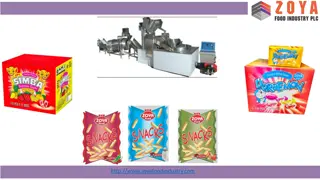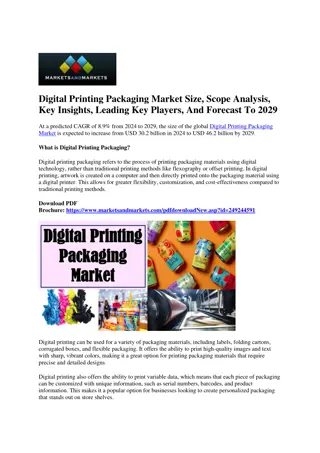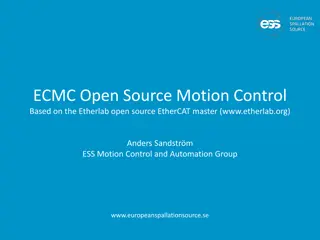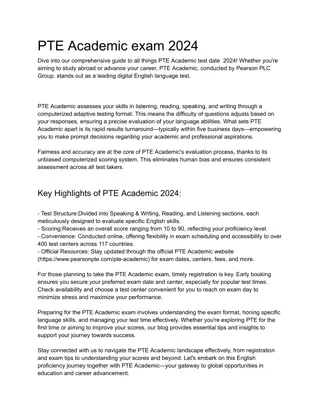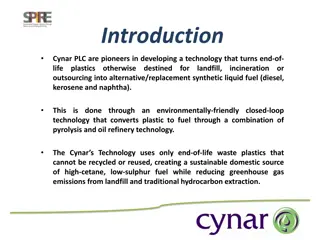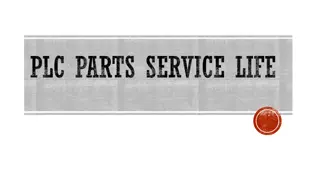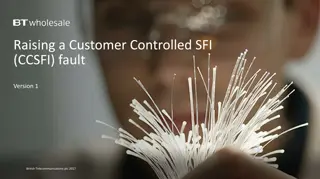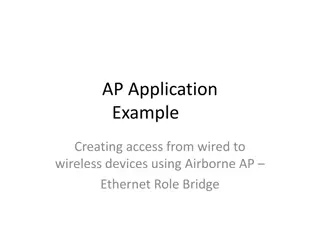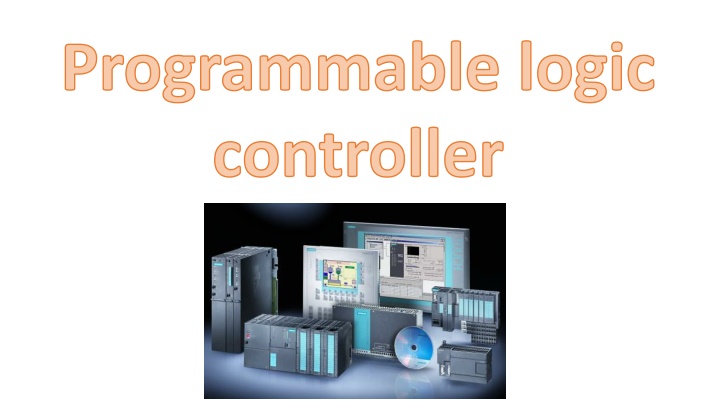
Industrial Control Systems and PLC Technology Overview
Explore the world of programmable logic controllers (PLCs) and industrial automation, including pneumatic and hydraulic systems, leading PLC brands, programming software, communication protocols, and common acronyms. Learn about the key components and applications of PLC technology in various industries.
Download Presentation

Please find below an Image/Link to download the presentation.
The content on the website is provided AS IS for your information and personal use only. It may not be sold, licensed, or shared on other websites without obtaining consent from the author. If you encounter any issues during the download, it is possible that the publisher has removed the file from their server.
You are allowed to download the files provided on this website for personal or commercial use, subject to the condition that they are used lawfully. All files are the property of their respective owners.
The content on the website is provided AS IS for your information and personal use only. It may not be sold, licensed, or shared on other websites without obtaining consent from the author.
E N D
Presentation Transcript
Programmable logic controller
Pneumatic and Hydraulic Power electronics Switchgear, Contactors and Relays Sensors and Actors Closed Loop Controller Automation Electronic Controls and Microcontroller Programmable Logic Controller Motors
Leading Brands of Leading Brands of PLC AMERICAN PLC EUROPEAN JAPANESE 1 ALLEN BRADLEY SIEMENS TOSHIBA 2 GOULD MODICON KLOCKNER & MOULLER OMRON 3 TEXAS INSTRUMENTS FESTO FANUC 4 GENERAL ELECTRIC TELEMECHANIQUE MITSUBISHI 5 WESTINGHOUSE 6 CUTTER HAMMER 7 SQUARE D
PLC Programing PLC Programing Software s 1. Velocio Software 2. Siemens Software 3. Rockwell Automation (Allen-Bradley) Software 4. Schneider Software 5. Mitsubishi Software 6. Modicon Software 7. Panasonic Software 8. Keyence Software 9. Telemecanique Software 10. Beckhoff Software 11. GE Software 12. Automation Direct Software 13. IDEC Software 14. Opto22 Software 15. Omron Software Software s 16. Sirea Software 17. VIPA Software 18. Triangle Research International Software 19. SPLAT Software 20. Smart Software Solutions 21. LSIS Software 22. Control Microsystems Software 23. Teco Software 24. Unitronics Software 25. ABB Software 26. Horner APG Software 27. Crouzet Software 28. Xinje Software 29. Entertron Software 30. Delta Electronics Software
PLC PLC Communications Communications Manufacturer 1 Allen-Bradley 2 Gould Modicon 3 General Electric 4 Mitsubishi 5 Square D 6 Texas Instruments Network Data Highway Modbus GE Net Factory LAN Melsec-NET SY/NET TIWAY
PLC Acronyms PLC Acronyms ASCII BCD CSA DIO EIA EMI HMI IEC IEEE I/O ISO LL LSB MMI MODICON MSB PID RF RIO RTU American Standard Code for Information Interchange Binary Coded Decimal Canadian Standards Association Distributed I/O Electronic Industries Association ElectroMagnetic Interference Human Machine Interface International Electrotechnical Commission Institute of Electrical and Electronic Engineers Input(s) and/or Output(s) International Standards Organization Ladder Logic Least Significant Bit Man Machine Interface MOdular DIgital CONtoller Most Significant Bit Proportional Integral Derivative (feedback control) Radio Frequency Remote I/O Remote Terminal Unit Supervisory Control And Data Acquisition SCADA
Definition of Definition of PLC According to NEMA standard ICS3-1978 A digitally operating electronic apparatus which uses a programming memory for the internal storage implementing specific functions such as logic, sequencing, timing, counting and arithmetic to control through digital or analog modules, various types of machines or process. PLC of instructions for
Areas of PLC Applications Areas of PLC Applications Casting Reactors Chemical Drilling Robots Color Mixing Rolling Compressors Security Systems Conveyors Stretch Wrap Cranes Slitting Crushing Sorting Cutting Stackers Turning Annunciators Injection Molding Auto Insertion Assembly Bagging Motor Winding Baking Oil Fields Blending Painting Boring Palletizers Brewing Pipelines Calendaring Polishing Digesters Stitching Drilling Stack Precipitators Electronic Testing Threading Elevators Tire Building Engine Test Stands Traffic Control Extrusion Textile Machine Forging Turbines Generators Gluing Weaving Grinding Web Handling Heat Treating Welding Manufacturing/ Machining Food / Beverage Metals Power Mining Petrochemical/Chemi cal
Relating the PLC Relating the PLC Traditional system PLC system control modified by physically changing the wiring between the devices This is costly and time consuming endeavor Soft wiring control function is modified by just changing the control program inside the PLC These changes are easy and cheap function is
PLC and PLC and Computer Computer A PLC and a computer both are electronic processor unit. The architecture of a PLC s CPU is basically same as that of a general purpose computer; however, some important characteristics set them apart. Unlike computer, PLCs are specifically designed to survive the harsh conditions of the industrial environment. A well-designed PLC can be placed in an area with substantial amounts of electrical noise, electromagnetic interference, mechanical vibration, and noncondensing humidity.
Cont. Cont. Distinction of PLCs is that their hardware and software are designed for easy use by plant electricians and technicians. The hardware interfaces for connecting field devices are actually part of the PLC itself and are easily connected. The modular and self-diagnosing interface circuits are able to pin point malfunctions and moreover, are easily removed and replaced.
Cont. Cont. Software programming uses conventional relay ladder symbols, or other easily learned languages, which are familiar to plant personnel. A computer can programming task and also multitasking. A standard PLC is designed to execute a single program in an orderly fashion. As PLCs are rapidly changing, multitasking capabilities. execute a complex modern PLCs have
Why PLCs are so popular? Why PLCs are so popular? Programmable logic controller have made it possible to precisely control large process machines and driven equipment with less physical wiring and wiring time than it requires with standard electro-mechanical relays, pneumatic system, timers, drum switches, and so on. The programmability allows for fast and easy changes in the relay ladder logic to meet the changing needs of the process or driven equipment without the need for expensive and time consuming rewiring process. Modem PLCs are "electrician friendly", PLC can be programmed and used by plant engineers and maintenance electricians without much electronic and computer programming background. They can programmed by using the existing ladder diagrams.
Advantage and disadvantage of PLC
Advantage of PLC No 1 Advantage Description Universal Controller Can replace various independent/ standalone controller. Do not have to rewiring relay panel. Change program using keyboard. Large number of' Soft Contact' available Advancement in technology and open architecture of PLC will reduce the market price. A program can be simulated or run without actual input connection. Can observe the opening and closing of contact switch on CRT. Operator message can be programmed for each possible malfunction. Depends on scan time -millisecond. Asynchronous operation. Flexibility 2 Implementing Changes and Correcting Errors Large Quantity of Contact Lower Cost 3 4 5 Pilot Running (Simulation Capability) Visual Observation. 6 7 Speed of Operation
Ladder or Boolean Programming Method. Easy for 'Electrician , Reliability 8 9 10 Simplicity of Ordering Control Sys. Components 11 Documentation 12 . Security 13 Ease of Changes by Programming In general -very reliable One package with Relay, Timers, Control Block, etc. Printout of ladder logic can be printed easily Software lock on a program (Password) Ability to program and reprogram, loading and down loading 14 Highly versatile (universal applicability) 15 Simple troubleshooting Simple installation 16 Quick modification of the program (highly flexible) 17 Capable of task not possible with relays before as indicated by the following: 18 Low space requirement 19 Low power consumption 20 High processing speed 21 No moving parts, hence no wearing parts Calculation, information exchange, text and graphic display, data processing, networking
Disadvantages of PLC Disadvantages N o 1 New Technology 2 Fixed program Application 3 Environment Consideration Description Change from ladder and relay to PLC concept Not cost effective for single- function application Not adapted for very high temperature, high humidity level, high vibration, etc. Does not start automatically when power failure ( can be programmed into ) Not "Fail-safe" -Fail-shorted rather than OPEN 4 Fail-safe operation 5 Fixed-circuit operation Fixed control system -less costly
What Is Inside A PLC? What Is Inside A PLC?
Cont. Cont. The Central Processing Unit, the CPU, contains an internal program that tells the PLC how to perform the following functions: Execute the Control Instructions contained in the User's Programs. This program is stored in "nonvolatile" memory, meaning that the program will not be lost if power is removed Communicate with other devices, which can include I/O Devices, Programming Devices, Networks, and even other PLCs. Perform Housekeeping activities such as Communications, Internal Diagnostics, etc.
How Does A PLC Operate? How Does A PLC Operate? There are four basic steps in the operation of all PLCs; Input Scan, Program Scan, Output Scan, and Housekeeping. These steps continually take place in a repeating loop. 1. Input Scan Detects the state of all input devices that are connected to the PLC Executes the user created program logic 2.Program Scan Energizes or de-energize all output devices that are connected to the PLC. 3. Output Scan 4.Housekeeping This step includes communications with programming internal diagnostics, etc... terminals,
What Programming Language Is Used To Program A PLC? What Programming Language Is Used To Program A PLC? While Ladder Logic is the most commonly used PLC programming language, it is not the only one. The following lists of some of languages that are used to program a PLC. 1. Ladder Diagram (LD) Traditional ladder logic is graphical programming language. Initially programmed with simple contacts that simulated the opening and closing of relays, Ladder Logic programming has been expanded to include such functions as counters, timers, shift registers, and math operations.
2. Function Block Diagram (FBD) 2. Function Block Diagram (FBD) A graphical language for depicting signal and data flows through re-usable function blocks. FBD is very useful for expressing the interconnection of control system algorithms and logic.
3. Structured Text (ST) 3. Structured Text (ST) A high level text language that encourages structured programming. It has a language structure (syntax) that strongly resembles PASCAL and supports a wide range of standard functions and operators. For example; If Speed1 > 100.0 then Flow_Rate: = 50.0 + Offset_A1; Else Flow_Rate: = 100.0; Steam: = ON End_If;
4. Instruction List (IL) 4. Instruction List (IL) A low level assemblerlike language that is based on similar instructions list languages found in a wide range of today s PLCs. LD MPC LD ST RESET: ST R1 RESET PRESS_1 MAX_PRESS LD 0 A_X43
5. Sequential Function Chart (SFC) 5. Sequential Function Chart (SFC) A method of programming complex control systems at a more highly structured level. A SFC program is an overview of the control system, in which the basic building blocks are entire program files. Each program file is created using one of the other types of programming languages. The SFC approach coordinates large, complicated programming tasks into smaller, more manageable tasks.
What Are Input/output Devices of PLC?
Input device Input device 1. Switches and Pushbuttons 2. Sensing Devices Limit Switches Photoelectric Sensors Proximity Sensors 3. Condition Sensors 4. Encoders Pressure Switches Level Switches Temperature Switches Vacuum Switches Float Switches
OUTPUTS OUTPUTS Valves Motor Starters Solenoids Actuators Horns and Alarms Stack lights Control Relays Counter/Totalizer Pumps Printers Fans

